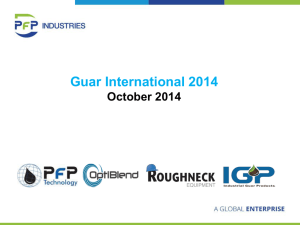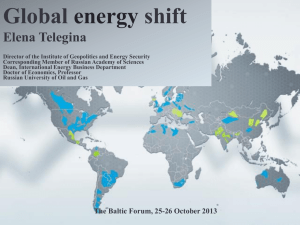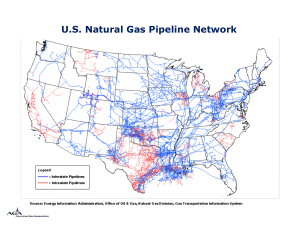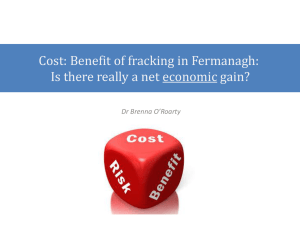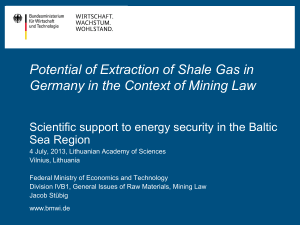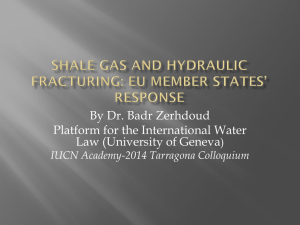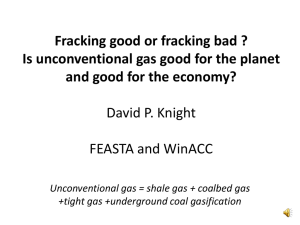View Conference Presentation
advertisement
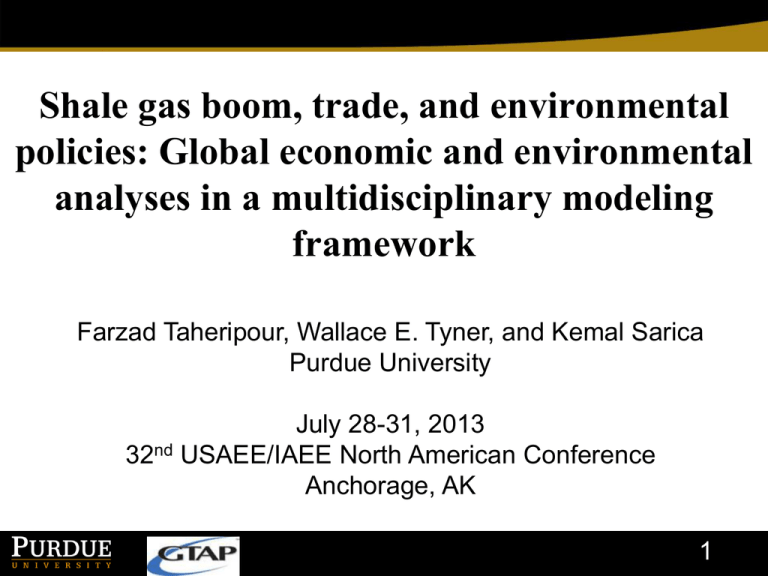
Shale gas boom, trade, and environmental policies: Global economic and environmental analyses in a multidisciplinary modeling framework Farzad Taheripour, Wallace E. Tyner, and Kemal Sarica Purdue University July 28-31, 2013 32nd USAEE/IAEE North American Conference Anchorage, AK 1 Outline Background and literature review, Expected expansion in shale oil and gas, A short review of existing work in this area, Objectives of this paper, Modeling framework, GTAP and MARKAL-Macro models, Modifications in the GTAP model and its data base, Experiments, Main numerical results, Conclusions. 2 Background (1) Expansion in shale oil and gas Expected oil production Expected gas production Source: Annual Energy outlook 2013 (DOE) 3 Background (2) Literature review Shale gas and environmental policies: Main conclusion: expansion in supply of natural gas in combination with appropriate carbon polices will help the US economy to achieve low-carbon standards in future [Brown et al. (2010), Paltsev (2011), Jacoby (2011)] Shale gas and gas exports: Gas export will benefit resource owners, negatively affect energy intensive industry, and increase domestic gas prices [NERA 2012, Deloitte 2011, Brooks (2012), Ditzel et al. (2013), Sarica and Tyner (2013)] Shale gas and economic impacts: Shale gas will improve welfare, positively affect GDP, and generates job and investment opportunities [IHS Global Insight Inc (2011), Citi GPS (2012) and Arora (2013)] 4 Background (3) Objective of this paper Exiting studies are mainly concentered on expansion in shale gas and have ignored the fact new extraction technologies will expand supplies of oil and gas jointly, They do not provide comprehensive economic and environmental analyses, This paper fills the gap in this area and evaluates economic and environmental impacts of expansion in shale oil and gas using a global hybrid modeling framework through 2035. 5 Modeling framework (1) A hybrid modeling framework Soft link Endowments: Labor, Land, Capital, and Resources Commodities: including energy GTAP model MARKAL-Macro model 6 Modeling framework (2) CES Production function and demands for inputs in the GTAP model 7 Modeling framework (3) CDE Expenditure function and household demands for good and services 8 Modeling framework (4) Major modifications in GTAP Correcting links between gas and gas distribution sectors, Improving firms’ demand for energy inputs, Dividing natural resources between oil-gas and other types of resource, Treatment of unemployment 9 Modeling framework (5) New CES Production function and demands for inputs in GTAP model 10 Experiments Three main experiments Experiment I: Changes in US oil and gas with no expansion in shale resources, Experiment II: Changes in US oil and gas with expansion in shale resources, while we assume no growth in crude oil exports, Experiment III: Changes in US oil and gas with expansion in shale resources, with no change in crude oil or natural gas exports. Petroleum product exports are free to expand, For each experiment, we run simulations for the following 5 time segments: 2007-12, 2012-17, 2017-2022, 2022-2027, and 2027-2035. 11 Major numerical results (1) % Changes in US production by sector 2007-2035 Experiment Experiment Experiment (%) Sectors I Crops Livestock Forestry Fishing Food Coal Oil Gas Gas Distribution Oil Products Electricity Energy Intensive Industries Other Industries Services II 0.0 -1.1 -0.8 -1.0 -1.2 1.2 -31.6 -16.6 -5.5 -4.8 -1.4 -0.5 -0.9 -1.5 III 0.0 1.7 1.2 1.4 1.9 -2.1 25.8 52.0 11.8 4.8 2.8 0.7 1.4 2.4 0.1 1.9 1.6 1.8 2.2 -5.6 25.8 52.0 25.4 4.9 4.4 2.1 1.9 2.6 12 Major numerical results (2) Changes in US prices by sector 2007-2035 (%) Sectors Crops Livestock Forestry Fishing Food Coal Oil Gas Gas Distribution Oil Products Electricity Energy Intensive Industries Other Industries Services Experiment Experiment I II -0.4 0.7 -0.5 0.8 -0.5 0.8 -0.1 0.5 -0.4 0.6 -0.3 0.4 9.3 -5.9 8.8 -16.0 4.8 -9.1 3.5 -2.9 0.8 -1.6 0.0 0.1 -0.3 0.5 -0.4 0.7 Experiment III 0.6 0.9 0.8 0.2 0.5 -0.9 -10.8 -24.1 -14.2 -4.5 -3.3 -0.2 0.5 0.7 13 Major numerical results (3) Changes in US GDP compared with 2007 14 Major numerical results (4) Changes in US labor & capital demands for 2007-2035 15 Major numerical results (5) Impacts on US trade balance 2007-2035 (figures are in $ million) Sectors Agriculture Products and Food All energy items Coal Oil Gas and Gas Distribution Oil Products Electricity Industry and services Total 2007-12 3,680 -43,602 155 -26,195 -14,307 -3,270 14 71,777 31,855 2012-17 -6,021 72,138 -212 14,658 55,812 1,884 -4 -115,831 -49,713 2017-22 -5,505 48,908 -67 14,042 30,294 4,314 325 -98,939 -55,536 16 Major numerical results (6) Changes in US welfare compared to 2007 17 Major numerical results (7) CO2 emissions per US dollar production at 2007 prices 18 Conclusions (1) The shale oil and gas boom has a major impact on the US economy, During the time period from 2008 through 2035 the US GDP on average would be 2.2% higher than its 2007 level with the expansion in shale resources, Without the expansion in shale resources on average the US GDP will be 1.3% lower than its 2007 level during the same time period, The expansion in shale resources boosts US GDP by 3.5% of its 2007 level during the time period 2008-37. 19 Conclusions (2) The welfare gains are also quite large, On average the welfare difference between the positive shock and the negative shock is $473 bil. per year over the time period from 2008 through 2035. If we restrict gas exports the magnitude of the annual difference increases to $487 billion, The shale boom creates substantial employment opportunities with jobs growing on average about 1.8% in the positive shock and declining about 1.1% in the negative shock for a net of about +2.9% employment gains. All of these figures are compared with 2007. 20 Conclusions (3) The expansion in shale resources improves the US energy trade balance by more than $72 billion in 2035 compared to 2007, With no expansion in shale resources the US net energy imports goes up by $44 billion in 2035 compared to 2007, Expansion in shale resources causes a worsening in the overall trade deficit driven by the increased level of economic activity. In the absence of emissions reduction policies, the expansion in shale resources will increase CO2 by 4.1% between 2007-2035, Imposing a restriction on gas exports improves economic welfare but increases CO2 emissions by 6.9%, The expansion in shale resources generates huge opportunities for the US economy to grow. 21 Thank you! Questions and Comments



